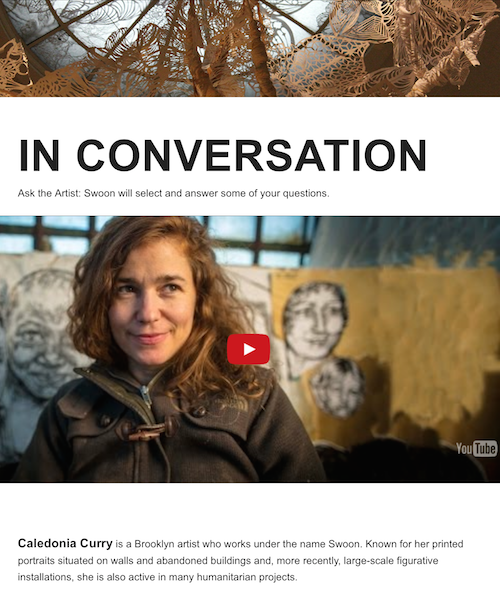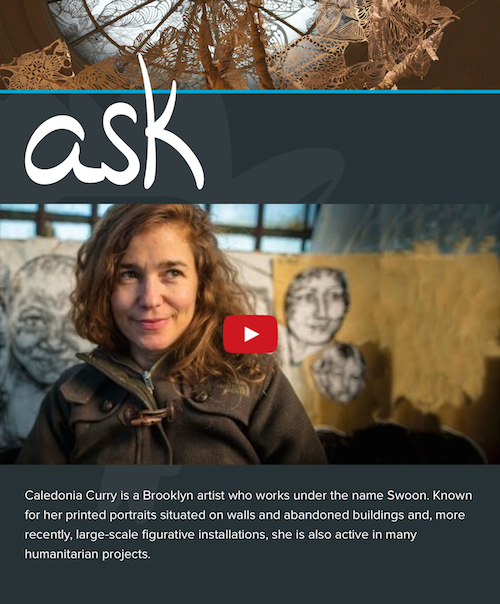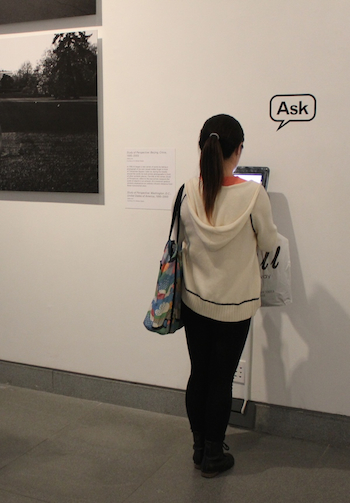Piloting the Complexities of Migrating iPad Kiosks into ASK
Brian and Jennie have been talking about our forthcoming mobile application, which is one of the public facing components of our Bloomberg Connects project, but our goal is to really transform our visitor experience from entry to exit and, also, to ensure that we are running a consistent technology program throughout the building. We know mobile will be one part of that, but it shouldn’t stand alone and while there are many public facing parts to the project that we will talk about at length, it’s also important for us to look at existing programs and re-evaluate them under the lens of ASK. Are there things we are doing right now that we can tweak into a similar format?

For our spring 2014 exhibitions, ipad kiosks started with a video call to action under the heading, “In Conversation.”
One example of this is our comment book kiosks, which you may remember started as generic electronic versions of comment books and then were tweaked into “In Conversation” kiosks—all running on ipads throughout our exhibitions. When we switched to the newer conversational format, the big change was a video call to action on the start screen. Nicely, the video format meant we could do anything in that initial call, so we started our experiment with content. As part of our spring 2014 exhibitions, we shifted the focus of those videos to “ask us a question” and both of our featured artists, Swoon and Ai Weiwei, answered visitor questions that were left on the ipads.

In our latest pilot, the same ipads have a re-branded start screen to match our ASK program for Bloomberg Connects.
For fall, we are continuing the “ask us a question” format, but we are extending it into certain areas of the permanent collection and, additionally, changing the design of the start screen to reflect the greater ASK program. The bonus? If this works, it can provide us with a way to make ASK functionality available to those who do not have (or do not want to use) a mobile device. Given these kiosks may become part of the greater Bloomberg Connects program we are thinking about a lot of issues as we move through this pilot.
At first glance, this seems easy, right? Change the start screen and the call to action and done(!), but there’s a lot more nuance that goes into a change like this one. Unlike our future mobile setup, these kiosks don’t operate in real time; the visitor gets their response via email after their visit, so we need to think about messaging and visitor expectations. Additionally, not everyone who leaves a question on one of these kiosks receives an answer—not the case in mobile.

There’s a big difference in responses given depending on if the device is fixed vs. mobile.
We are also thinking a lot about differences in contributed content and how different an “ask” can be from a fixed device to a mobile one. These ipads are in a fixed position in the galleries, so the questions that we get through them are slightly different. So far, we’ve seen questions from the kiosks either more general in nature—about the overall themes in the show and/or about works of art installed very near where the kiosk is mounted. Testing on mobile has, so far, seen questions that tend to be much more specific and granular—about single works of art and about any work of art in the gallery because the device goes with the user. Does the resulting content from two slightly different iterations mesh together well enough?
From an administrative perspective—vetting questions, providing responses, managing users—we wonder if this system needs to be integrated into the ASK management and, if so, what that would look like. There are benefits to integration because it could help a single dedicated staff manage all ask/answer content in the building using a single administrative setup, but there’s a large technical overhead in merging the two systems.
So, there’s a lot of complexity and this pilot is an important one because it allows us to tweak an existing setup and learn from it before we build and/or combine programs. Sara is up next to talk about some additional changes we are making to these kiosks based on visitor observation in those spring exhibitions.

Shelley Bernstein is the former Vice Director of Digital Engagement & Technology at the Brooklyn Museum where she spearheaded digital projects with public participation at their center. In the most recent example—ASK Brooklyn Museum—visitors ask questions using their mobile devices and experts answer in real time. She organized three award-winning projects—Click! A Crowd-Curated Exhibition, Split Second: Indian Paintings, GO: a community-curated open studio project—which enabled the public to participate in the exhibition process.
Shelley was named one of the 40 Under 40 in Crain's New York Business and her work on the Museum's digital strategy has been featured in the New York Times.
In 2016, Shelley joined the staff at the Barnes Foundation as the Deputy Director of Digital Initiatives and Chief Experience Officer.


Start the conversation